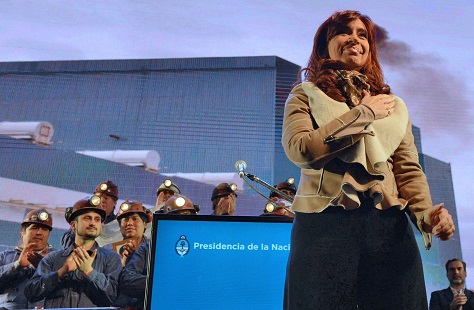
Despite Daniel Scioli’s seemingly easy rise over the course of 2015 to become the frontrunner for the Argentine presidency after the October 25 general election, the most persistent criticism he faces is that he will not be his own man in office, but instead a puppet — or even a placeholder — of Cristina Fernández de Kirchner.![]()
Term limits are forcing Kirchner to step down, after eight years in office that followed four previous years when her late husband, Néstor Kirchner occupied the Casa Rosada. This year’s election will be the first since 1999 when a Kirchner hasn’t been on the ballot, and there’s already plenty of speculation that Scioli is just a transitional figure designed to bridge two eras of kirchnerismo.
There’s probably something to those rumors. Kirchner herself succeeded her own husband, in what was widely discussed as a plan to pass the presidency between the two (a plan that went sideways when Néstor died in 2010). If her party had won a two-thirds majority in the 2013 midterm elections, it was entirely plausible that they might have amended Argentina’s constitution to provide her a path to a third consecutive term.
There’s nothing necessarily nefarious about Kirchner’s plans, if true, to return to the presidency in 2019. In Latin America, where executive-strong governments are often checked by strict term limits (in many cases, presidents are limited to a single consecutive term), it’s not unusual for popular former presidents to return to office. That’s currently true for two of Argentina’s neighbors — Uruguay reelected left-wing Tabaré Vázquez to the presidency last December after a four-year stint out of office; Chile did the same, where the center-left Michelle Bachelet returned to office, after an equal four-year break, in December 2013.
Despite (or perhaps because of) the sinking popularity of Brazilian president Dilma Rousseff, a widespread corruption scandal and a tough economy, the widely-loved Luiz Inácio Lula da Silva is openly considering a run in the 2018 election after eight years out of office.
Even in the United States, it’s still a good bet to assume that the wife of a former president will face off for the presidency in 2016 against the son and brother of two other former presidents.
*****
RELATED: Scioli leads in Argentine presidential race after primaries
*****
But for Scioli, the Kirchner legacy is much more complicated, and the specter of a Kirchner restoration could drain much of his credibility as an Argentine president — especially among a business class that hopes he will (however gently) reverse course on nationalization, capital controls and Argentina’s freeze in global debt markets, pushing Argentina to a more orthodox economy.
All of that rests on the willingness of Kirchner and her many allies to give Scioli a chance to govern — or on the ability of Scioli to push them to the sidelines.
In exchange for Kirchner’s endorsement and a clear run at the presidential nomination of Kirchner’s governing Frente para la Victoria (FpV, the Front for Victory) — and therefore the all-important relay torch of peronismo — Scioli agreed to appoint longtime Kirchner ally Carlos Zannini, a Marxist-leaning attorney and presidential legal secretary since 2003, as his running mate.
But if Scioli wins, Zannini will not be the only kirchnerista left behind in his government. Many of her appointees, from the boards of newly nationalized industries (including the state oil company, YPF, and the state airline, Aerolineas Argentinas) to nine of the 10 directors of the central bank, will remain. Earlier this year, in the aftermath of the shady assassination of a prosecutor investigating accusations against Kirchner, the president created a new intelligence agency (AFI) whose officials owe their positions to Kirchner, not Scioli.
Axel Kicillof, Kirchner’s young, leftist economy minister, is running as the FpV’s high-profile candidate in the city of Buenos Aires for Argentina’s simultaneous congressional elections.
Scioli, the outgoing governor of the province of Buenos Aires, is not a natural successor to the Kirchners. A powerboat racer (who lost his right arm in a 1989 sporting accident), Scioli began his career in politics under the more liberal Carlos Menem, Argentina’s president in the 1990s. Scioli has always been on the right flank of the peronista Justicialist Party that forms the heart of the FpV, serving as Néstor Kirchner’s vice president from 2003 to 2007, thereupon winning the governorship of Buenos Aires, by far the country’s most populous province, home to nearly 17 million of the country’s 42 million citizens.
He’s already clinging to a play-it-safe strategy — he avoided a high-profile debate among the other candidates earlier this week.
Doubts about Scioli could prevent him from winning the presidency outright on October 25 — he needs to win either 45% of the vote or 40% of the vote (with a margin of 10% over the nearest competitor), and polls show that he’s right on the margin. If the presidential race goes to a November 22 runoff, Scioli could face an even tougher fight against the center-right candidate, Mauricio Macri, the outgoing mayor of the city of Buenos Aires.
Kirchner’s approval ratings have improved somewhat in the past year, despite stubborn inflation and economic doldrums that have brought the commodity-heavy economies of Chile and Brazil into recession. If the electorate believes that Scioli is just a placeholder for Kirchner, though, his lead could evaporate. If he’s forced into a runoff with Macri, it’s likely that many of the supporters of Tigre mayor Sergio Massa, an alternative peronista candidate now polling in third place, will flock to Macri, whose moderating tone has made him a credible threat in a one-on-one contest in November.
One thought on “Kirchner 2019 comeback could complicate Scioli presidential bid”